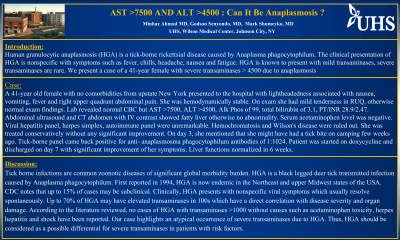Back


Poster Session D - Tuesday Morning
Category: Liver
D0610 - AST > 7500, ALT > 4500: Can It Be Anaplasmosis?
Tuesday, October 25, 2022
10:00 AM – 12:00 PM ET
Location: Crown Ballroom

Has Audio
- MA
Minhaz Ahmad, MD
United Health Services Hospital
Johnson City, NY
Presenting Author(s)
Minhaz Ahmad, MD1, Godson Senyondo, MD2, Nasrin Chowdhury, 2, Mark Shumeyko, MD1
1United Health Services Hospital, Johnson City, NY; 2UHS, Johnson City, NY
Introduction: Human granulocytic anaplasmosis (HGA) is a tick-borne rickettsial disease caused by Anaplasma phagocytophilum. The clinical presentation of HGA is nonspecific with symptoms such as fever, chills, headache, nausea and fatigue. HGA is known to present with mild transaminases, severe transaminases are rare. We present a case of a 41-year female with severe transaminases > 4500 due to anaplasmosis.
Case Description/Methods: A 41-year old female with no comorbidities from upstate New York presented to the hospital with lightheadedness associated with nausea, vomiting, fever and right upper quadrant abdominal pain. She was hemodynamically stable. On exam she had mild tenderness in RUQ, otherwise normal exam findings. Lab revealed normal CBC but AST >7500, ALT >4500, Alk Phos of 99, total bilirubin of 3.1, PT/INR 28.9/2.47. Abdominal ultrasound and CT abdomen with IV contrast showed fatty liver otherwise no abnormality. Serum acetaminophen level was negative. Viral hepatitis panel, herpes simplex, autoimmune panel were unremarkable. Hemochromatosis and Wilson's disease were ruled out. She was treated conservatively without any significant improvement. On day 3, she mentioned that she might have had a tick bite on camping few weeks ago. Tick-borne panel came back positive for anti- anaplasmosma phagocytophilum antibodies of 1:1024. Patient was started on doxycycline and discharged on day 7 with significant improvement of her symptoms. Liver functions normalized in 6 weeks.
Discussion: Tick borne infections are common zoonotic diseases of significant global morbidity burden. HGA is a black legged deer tick transmitted infection caused by Anaplasma phagocytophilum. First reported in 1994, HGA is now endemic in the Northeast and upper Midwest states of the USA. CDC notes that up to 15% of cases may be subclinical. Clinically, HGA presents with nonspecific viral symptoms which usually resolve spontaneously. Up to 70% of HGA may have elevated transaminases in 100s which have a direct correlation with disease severity and organ damage. According to the literature reviewed, no cases of HGA with transaminases >1000 without causes such as acetaminophen toxicity, herpes hepatitis and shock have been reported. Our case highlights an atypical occurrence of severe transaminases due to HGA. Thus, HGA should be considered as a possible differential for severe transaminases in patients with risk factors.
Disclosures:
Minhaz Ahmad, MD1, Godson Senyondo, MD2, Nasrin Chowdhury, 2, Mark Shumeyko, MD1. D0610 - AST > 7500, ALT > 4500: Can It Be Anaplasmosis?, ACG 2022 Annual Scientific Meeting Abstracts. Charlotte, NC: American College of Gastroenterology.
1United Health Services Hospital, Johnson City, NY; 2UHS, Johnson City, NY
Introduction: Human granulocytic anaplasmosis (HGA) is a tick-borne rickettsial disease caused by Anaplasma phagocytophilum. The clinical presentation of HGA is nonspecific with symptoms such as fever, chills, headache, nausea and fatigue. HGA is known to present with mild transaminases, severe transaminases are rare. We present a case of a 41-year female with severe transaminases > 4500 due to anaplasmosis.
Case Description/Methods: A 41-year old female with no comorbidities from upstate New York presented to the hospital with lightheadedness associated with nausea, vomiting, fever and right upper quadrant abdominal pain. She was hemodynamically stable. On exam she had mild tenderness in RUQ, otherwise normal exam findings. Lab revealed normal CBC but AST >7500, ALT >4500, Alk Phos of 99, total bilirubin of 3.1, PT/INR 28.9/2.47. Abdominal ultrasound and CT abdomen with IV contrast showed fatty liver otherwise no abnormality. Serum acetaminophen level was negative. Viral hepatitis panel, herpes simplex, autoimmune panel were unremarkable. Hemochromatosis and Wilson's disease were ruled out. She was treated conservatively without any significant improvement. On day 3, she mentioned that she might have had a tick bite on camping few weeks ago. Tick-borne panel came back positive for anti- anaplasmosma phagocytophilum antibodies of 1:1024. Patient was started on doxycycline and discharged on day 7 with significant improvement of her symptoms. Liver functions normalized in 6 weeks.
Discussion: Tick borne infections are common zoonotic diseases of significant global morbidity burden. HGA is a black legged deer tick transmitted infection caused by Anaplasma phagocytophilum. First reported in 1994, HGA is now endemic in the Northeast and upper Midwest states of the USA. CDC notes that up to 15% of cases may be subclinical. Clinically, HGA presents with nonspecific viral symptoms which usually resolve spontaneously. Up to 70% of HGA may have elevated transaminases in 100s which have a direct correlation with disease severity and organ damage. According to the literature reviewed, no cases of HGA with transaminases >1000 without causes such as acetaminophen toxicity, herpes hepatitis and shock have been reported. Our case highlights an atypical occurrence of severe transaminases due to HGA. Thus, HGA should be considered as a possible differential for severe transaminases in patients with risk factors.
Disclosures:
Minhaz Ahmad indicated no relevant financial relationships.
Godson Senyondo indicated no relevant financial relationships.
Nasrin Chowdhury indicated no relevant financial relationships.
Mark Shumeyko indicated no relevant financial relationships.
Minhaz Ahmad, MD1, Godson Senyondo, MD2, Nasrin Chowdhury, 2, Mark Shumeyko, MD1. D0610 - AST > 7500, ALT > 4500: Can It Be Anaplasmosis?, ACG 2022 Annual Scientific Meeting Abstracts. Charlotte, NC: American College of Gastroenterology.
